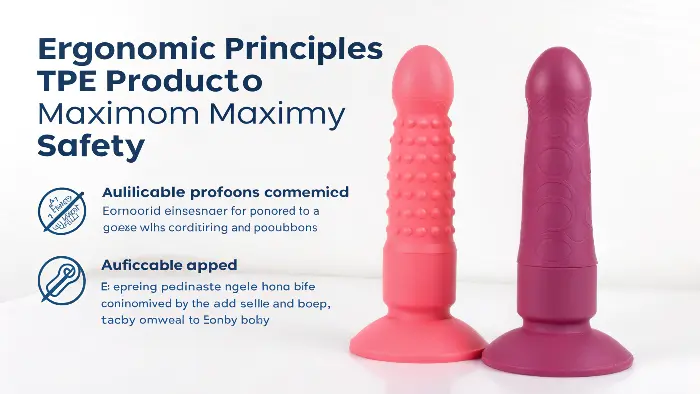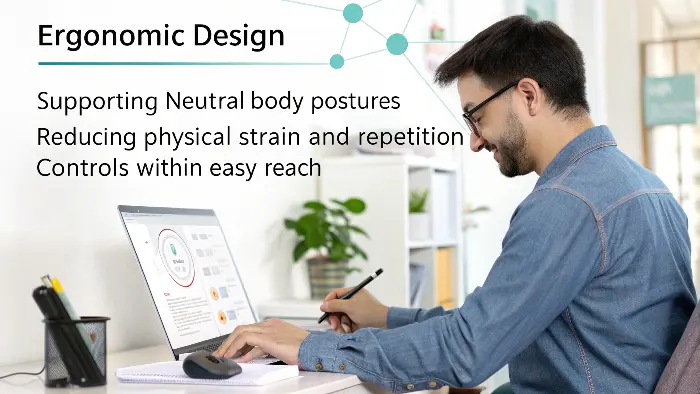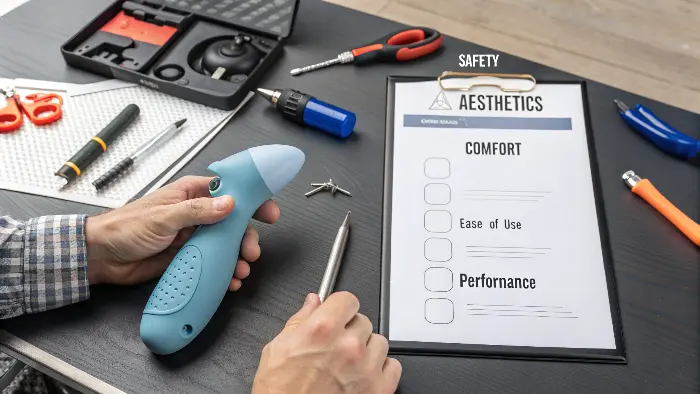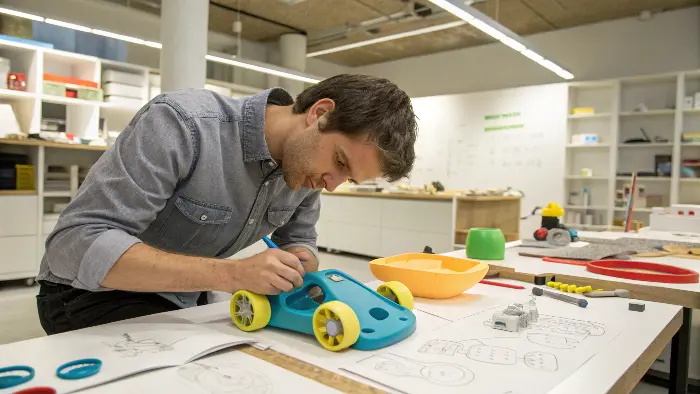Have you ever seen an adult toy that looks stunning but is awkward or uncomfortable to use? It’s a common problem where aesthetics are prioritized over the user’s actual a experience. This design failure leads to disappointment, bad reviews, and kills any chance of a customer coming back for more.
Applying ergonomic principles to TPE adult products means designing for the human body’s shape, movement, and limitations to enhance safety and pleasure. This is a safety engineering approach that prioritizes body-safe materials, comfortable forms, intuitive controls, and features like flared bases on insertables to create an experience that is both pleasurable and fundamentally secure.

When I first entered this industry, I was focused on the mechanics—the motors, the materials, the molding. But I quickly learned a powerful lesson from a product we were developing. It was powerful, the TPE was a fantastic quality, but our testers found it tiring to hold. The grip was wrong. We had engineered a great machine, but a poor tool. That experience taught me that ergonomics isn’t a "nice-to-have"; it’s the bridge between a product’s function and a person’s satisfaction. For brand owners like you, understanding this is the key to creating products that customers don’t just use, but love.
What Are the Core Principles of Ergonomic Design?
You see the word "ergonomic" stamped on everything from office chairs to kitchen gadgets, but what does it really mean for an adult toy? It’s easy for the term to become a hollow marketing buzzword. If you can’t define what makes a design truly ergonomic, you can’t properly evaluate a new product or give effective feedback to your manufacturer.
The core principles of ergonomic design are to make interaction with a product easier, more comfortable, and safer by fitting the product to the user, not the other way around. This means designing to support neutral body postures, reduce physical strain and repetition, and ensure controls are within easy, intuitive reach for a seamless user experience.

Dive Deeper
At its heart, ergonomics is the science of designing things for people to use effectively and safely. For something as intimate as an adult product, these principles are not just about comfort—they are fundamental to safety and pleasure. When we design a new toy at PrivyPlay, we filter every decision through these core ergonomic lenses.
1. Design for the User
This is the golden rule. We aren’t designing for a hypothetical person; we are designing for a diverse range of bodies and preferences. This means considering anthropometry—the study of human body measurements. We look at data for hand sizes to determine the ideal grip diameter for a wand or vibrator. We study anatomy to create curves on an insertable toy that align with the body. The goal is to make the product feel like a natural extension of the user’s body, which requires starting with a deep understanding of who that user is.
2. Maintain Neutral Postures
A neutral posture is one where the body is resting and under the least amount of stress. A poorly designed toy forces the user into awkward positions.
- For Handheld Toys: Think about the angle of the wrist. A handle that forces your wrist to bend sharply will cause fatigue and discomfort quickly. We design our handles to keep the wrist in a straight, neutral line with the forearm.
- For Insertable Toys: The curvature should complement the body’s internal shape, not fight against it. A G-spot vibrator with the wrong angle will be ineffective and uncomfortable. Our design process involves creating numerous prototypes to find the curve that provides the best contact without causing strain.
3. Reduce Excessive Force and Repetition
This principle is about minimizing the physical effort required to use the product.
- Activation Force: How hard do you have to press a button? If it’s too hard, it’s frustrating. If it’s too easy, it can be activated accidentally. We test our buttons to find the sweet spot.
- Grip: The texture and material of the handle are crucial. A slick, hard plastic handle requires a tight, forceful grip, especially when things get slippery. We use soft, matte-finish TPE that provides a secure, comfortable grip with less effort.
- Weight & Balance: A top-heavy toy is difficult to control and tiring to hold. We carefully consider the placement of the motor and battery to ensure the product is well-balanced in the hand.
By building on these principles, we create a product that feels right because it has been engineered to work in harmony with the human body.
What Are the Five Key Aspects of Ergonomic Design?
Knowing the general principles is a great start, but how do you apply them in a practical way during product development? You need a more concrete framework to evaluate a design. Without a checklist, you risk overlooking a critical element that could make or break the user experience.
The five key aspects of ergonomic design are safety, comfort, ease of use, performance, and aesthetics. For a TPE adult toy, this means it must be fundamentally body-safe, feel good to hold and use, have simple controls, effectively deliver pleasure, and be visually appealing. A successful design balances all five of these aspects perfectly.

Dive Deeper
When you’re giving feedback on a prototype, thinking in terms of these five aspects can make your comments much more specific and actionable. Instead of saying "I don’t like it," you can say, "The performance is great, but the comfort is lacking because the handle is too slick." Here’s how we break down each aspect for our TPE products.
| Ergonomic Aspect | Application in TPE Adult Products |
|---|---|
| 1. Safety | This is non-negotiable and always comes first. It means using medical-grade, phthalate-free TPE. It includes design features like a flared base on any toy intended for anal use to prevent it from getting lost. It also means ensuring the product is fully waterproof (IPX7) for hygienic cleaning. Safety is the foundation upon which all other aspects are built. |
| 2. Comfort | This is about the tactile experience. How does it feel in the hand and against the skin? We achieve comfort by selecting the right TPE shore hardness (softness), ensuring a smooth, seamless finish with no rough molding lines, and designing a weight and balance that makes the toy feel effortless to hold for extended periods. |
| 3. Ease of Use | Also known as usability, this is about how intuitive the product is. Can a user pick it up and understand how to turn it on, cycle through patterns, and turn it off without reading a manual? This involves thoughtful button placement (easy to reach but not accidentally press), clear icons, and simple charging methods like a magnetic USB port. |
| 4. Performance | A product can be safe, comfortable, and easy to use, but if it doesn’t do its job well, it’s a failure. Ergonomics directly impacts performance. The shape of a vibrator head determines how and where it delivers vibrations. The flexibility of a G-spot toy determines if it can hit the right spot. The design must enhance the function, not hinder it. |
| 5. Aesthetics | This is how the product looks and the emotional response it evokes. While beauty is subjective, good ergonomic design often results in elegant, pleasing forms because they follow natural curves. The aesthetics should invite the user, conveying quality and care in its design. Color, form, and finish all play a role in creating a desirable product. |
A great product doesn’t excel in just one or two of these areas; it finds a harmonious balance between all five. A cheap, ugly toy might perform okay, but it fails on aesthetics and likely safety. A beautiful toy that’s hard to use fails on usability. We strive for excellence across the board.
What Is the Ergonomic Design Approach in Practice?
Okay, so you understand the principles and the key aspects. But how does an idea for a new toy actually become a final, ergonomic product? It’s not magic. A great ergonomic design is the result of a deliberate, structured, and user-focused process. Without this process, you’re just guessing and hoping for the best.
The ergonomic design approach is an iterative cycle of research, prototyping, testing, and refinement. It begins with deeply understanding the user’s needs, then creating physical models to test shape and feel, and finally using feedback from real user testing to systematically improve the design before committing to expensive production tooling.

Dive Deeper
This iterative process is crucial because it’s impossible to get ergonomics perfect on the first try. You have to be willing to test, fail, learn, and improve. Here’s a look at the step-by-step approach we take at PrivyPlay, which you as a brand owner would be a key part of.
Phase 1: Research and Definition
Before we sketch anything, we define everything.
- Who is the user? Are we designing for beginners or experienced users? Individuals or couples? This defines the size, power, and feature set.
- What is the primary use case? Is it for internal or external stimulation? Clitoral, G-spot, or prostate? This dictates the fundamental shape.
- What are the ergonomic goals? For a travel toy, the goal might be a compact size and discreet grip. For a powerful wand, the goal might be heat dissipation and a vibration-dampening handle.
Phase 2: Ideation and Concept Modeling
This is where creativity meets constraints. Our industrial designers will sketch dozens of forms. We then move the best ideas into 3D CAD software. At this stage, we can quickly rotate and analyze the form from every angle, comparing it against our ergonomic principles. We’re already thinking: Is the button reachable? Is the curve anatomically sound?
Phase 3: Prototyping and Testing (The Loop)
This is the most important phase. We have to get the design out of the computer and into people’s hands.
- 3D-Printed Models: We start with fast, low-cost 3D prints. These are non-functional but allow us to test the most basic things: How does it feel to hold? Is the size right? Is the grip secure? We might go through 5-10 variations at this stage alone based on initial feedback.
- Functional Prototypes: Once the shape is close, we create a soft tool to mold prototypes from the actual TPE material. These prototypes have the final texture, softness, and working electronics.
- User Testing: We then give these functional prototypes to a small, trusted group of testers. We don’t just ask, "Do you like it?" We ask specific, ergonomic questions: "On a scale of 1-10, how comfortable was the grip after 5 minutes?", "Were you ever able to press the power button by accident?", "Was the angle effective for reaching your target area?".
Phase 4: Refine and Finalize
The feedback from user testing is gold. We collect all of it and use it to make precise adjustments to the 3D model. Maybe we need to change a curve by 3 degrees, add a textured pattern to the handle, or move a button 5mm to the left. Then, we may create a new prototype and test again. We repeat this loop until the feedback is overwhelmingly positive. Only then do we approve the design for mass production tooling. This methodical approach minimizes risk and ensures the final product is one we can be proud of.
How Do You Design an Ergonomic Safety System into a Product?
It’s a brand owner’s worst nightmare: a customer gets hurt using your product. While a toy can feel comfortable and be easy to use, it can still harbor hidden safety risks. An oversight in the design—like a missing retrieval feature or a material that degrades—can have devastating consequences for both your customers and your brand’s reputation.
Designing an ergonomic safety system means embedding safety features directly into the product’s physical form and function, making safety intuitive and almost automatic for the user. This goes beyond just material choice; it involves shaping the product to be anatomically safe, such as including a flared base, and designing controls to prevent sudden, unexpected actions.

Dive Deeper
Safety shouldn’t be a separate feature; it should be integrated into the very DNA of the design through ergonomics. It’s about anticipating how a person will use—and potentially misuse—a product and creating safeguards. Here’s how we engineer safety into our TPE products from the ground up.
1. Material Safety as a Foundation
This is the baseline. The ergonomics of material choice is about biocompatibility. The material will be in contact with the most sensitive parts of the body.
- Medical-Grade TPE: We exclusively use medical-grade Thermoplastic Elastomer. This means it has been tested for cytotoxicity according to standards like ISO 10993, ensuring it is non-toxic and non-irritating.
- Phthalate-Free & Body-Safe: Our materials are guaranteed to be free from phthalates, latex, and other harmful chemicals that are unfortunately still found in cheap, unregulated toys. We can provide the material safety data sheets (MSDS) to prove it.
2. Physical Safety by Design (Ergonomic Form)
This is where the shape of the product itself becomes a safety feature.
- The Flared Base: This is the most critical ergonomic safety feature for any toy designed for anal use. The anal sphincter and rectum are strong muscles that can pull an object fully inside the body, leading to a medical emergency. A base that is significantly wider than the insertable part of the toy makes this physically impossible. The design of the base itself must also be ergonomic—easy to hold onto.
- Smooth, Seamless Construction: We design our molds to minimize parting lines (the seam where mold halves meet). Any seams are polished smooth to prevent microscopic tears or irritation. The overall shape has no sharp points or sudden edges.
- Secure Retrieval Features: For any insertable product, there must be an easy way to remove it. This could be a flared base, a T-bar handle, or a retrieval ring. The ergonomics here dictate that the feature must be easy to grip, even when slippery with lubricant.
3. Functional and Hygiene Safety
- IPX7 Waterproofing: We design our toys to be fully submersible. While great for shower play, the primary purpose is hygiene. A truly waterproof design has no openings for bacteria to enter, allowing for safe, thorough washing with soap and water. This is a crucial ergonomic feature for health.
- Intuitive and Safe Controls: The control interface can also be a safety feature. We avoid single-button designs that cycle from off, to low, and then straight to maximum power. A sudden, unexpected jump in intensity can be startling or even painful. We prefer designs with separate "up" and "down" buttons or a "hold to increase" function that gives the user full, predictable control.
By thinking of safety as an engineering challenge to be solved with ergonomic principles, we create products that customers can explore with confidence and peace of mind.
Conclusion
Ergonomic design is not an abstract concept or a simple marketing claim. It is a rigorous, user-focused discipline that is the absolute foundation of any safe, effective, and desirable adult product. It’s the thoughtful process that ensures a product feels as good as it looks, safeguarding your customers and your brand.
